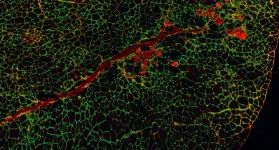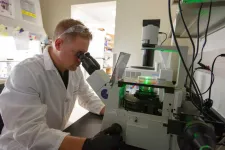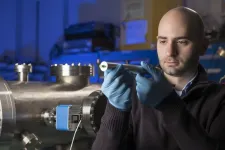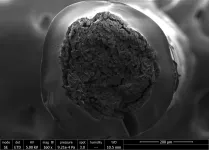Urolithin A shows effective against muscular dystrophy
2021-04-07
(Press-News.org) Progression of Duchenne Muscle Dystrophy (DMD) can be delayed in mice by supplementing their diets with Urolithin A, according to new results reported today. The findings, published in Science Translational Medicine, raise hopes that new treatment options could one-day be developed for DMD, an uncurable genetic condition characterized by progressive muscle degeneration. About 1 in 3,500 boys are born with DMD, which usually develops in childhood and significantly reduces life expectancy.
The new research carried out at the laboratory of Professor Johan Auwerx, MD, PhD at the Swiss Federal Institute of Technology EPFL and the University of Lausanne in collaboration with scientists at the Swiss life science company Amazentis, highlights the important role that defective mitochondria can play in DMD. The powerhouses of cells, mitochondria produce the energy necessary for normal muscle function. But muscle cells taken from both human DMD patients and from mice bred to mimic the condition show significant defects in mitochondrial activity, the study finds. Specifically, patterns of gene expression show the development of DMD is associated with a marked decrease in mitophagy - the process cells rely on to remove and recycle defective mitochondria and maintain energy levels high.
"Duchenne Muscle Dystrophy is the most common fatal genetic disease diagnosed in childhood with still no cure available," says Johan Auwerx, MD, PhD, lead-author and Professor at the EPFL. "Our work represents a significant breakthrough in the search for new therapeutic approaches for muscular dystrophies."
The natural compound Urolithin A is known to activate mitophagy and improve mitochondrial health in both mice and humans. When the study scientists and lead authors, Peiling Luan and Davide D'Amico, fed the compound to DMD mice for just ten weeks, they saw mitophagy levels rise effectively restoring them to normal. This led to a significant reduction of muscle damage and improvement in muscle health and performance. The DMD mice administered Urolithin A saw grip strength increase by 31% and running performance increase by 45% compared with control untreated animals. And they lived longer - survival increased by 40%.
Importantly for the human disease, Urolithin A reduced a damaging condition called fibrosis in muscles of the DMD mouse heart and diaphragm by 36% and 39%, respectively. Similar damage seen in DMD patients typically leads to fatal cardiac or respiratory failure. Urolithin A was also able to enhance the regeneration of mouse muscle stem cells. This is particularly relevant to the disease in humans as the onset of DMD is linked with the exhaustion of functional stem cells.
Davide D'Amico, PhD, Project Leader at Amazentis and a first author of the paper, said: "Prior to this study, it was understood that the dramatic loss of muscle function in DMD patients was associated with mitochondrial dysfunctions. Here we discovered that defective mitophagy, the removal and recycling of dysfunctional mitochondria, plays a key role in the progression of DMD."
Chris Rinsch, PhD, Co-founder and CEO of Amazentis, said, "The rigorous science being published in Science Translational Medicine strengthens the scientific evidence of Urolithin A as a potent enhancer of muscle function. It's exciting to see this natural metabolite can support not only healthy muscle, but also shows promise for progressive muscle diseases in pre-clinical research."
INFORMATION:
The results are reported in the current issue of Science Translational Medicine in the article: "Urolithin A improves muscle function by rescuing mitophagy in muscular dystrophy".
Background on Urolithin A
Amazentis' proprietary lead product is an oral formulation of Urolithin A. Urolithin A is a microflora-derived metabolite of ellagitannins, a class of compounds found in the pomegranate and other fruits and nuts. Administration of Urolithin A leads to improved mitochondrial function by stimulating mitophagy, a process by which aging and damaged mitochondria are cleared from the cell, stimulating growth of healthy mitochondria. Mitophagy declines in cells as we age, and the reduction in mitochondrial function in the muscles is thought to be one of the main causes of age-related muscle decline. Previously, Amazentis and the EPFL reported preclinical results in Nature Medicine in an article titled, "Urolithin A induces mitophagy and prolongs lifespan in C. elegans and increases muscle function in rodents" (doi:10.1038/nm.4132) and clinical results showing Urolithin A's safety, bioavailability and its impact on biomarkers of mitochondrial health in Nature Metabolism in an article entitled "The mitophagy activator urolithin A is safe and induces a molecular signature of improved mitochondrial and cellular health in humans (doi: 10.1038/s42255-019-0073-4). For more information, please visit http://www.mitopure.com.
About Amazentis
Amazentis is an innovative life science company that employs today's leading research and clinical science to develop the next generation of products targeting mitochondrial health for advanced nutrition. The company has recently concluded two clinical trials evaluating the benefits of Urolithin A on skeletal muscle in healthy adults. For more information on Amazentis, please visit http://www.amazentis.com.
[Attachments] See images for this press release:

ELSE PRESS RELEASES FROM THIS DATE:
2021-04-07
The lungs were for a long time considered to be sterile in health, while in diseases like chronic obstructive pulmonary disease (COPD) failure in immune mechanisms were thought to allow microorganisms to proliferate and persist. New sequencing techniques have shown that several microorganisms reside in the lungs of healthy individuals, as well. Few studies have examined the fungal community in COPD and compared it to healthy controls using such techniques. According to the study findings, the compositions of these environments seem to be unaffected by the use of inhaled steroids.
Lungs have a unique fungal environment
The Bergen COPD Microbiome study (short name "MicroCOPD") is the world's largest single-centre study on the fungal community in ...
2021-04-07
JUPITER, FL - People with Crohn's disease are typically treated with powerful anti-inflammatory medications that act throughout their body, not just in their digestive tract, creating the potential for unintended, and often serious, side effects. New research from the lab of Mark Sundrud, PhD, at Scripps Research, Florida suggests a more targeted treatment approach is possible.
Crohn's disease develops from chronic inflammation in the digestive tract, often the small intestine. More than half a million people in the United States live with the disease, which can be debilitating and require repetitive surgeries to remove irreversibly damaged intestinal tissue.
Writing in the journal Nature on April 7, Sundrud's team finds that certain immune cells ...
2021-04-07
Tracking carbon dioxide levels indoors is an inexpensive and powerful way to monitor the risk of people getting COVID-19, according to new research from the Cooperative Institute for Research in Environmental Sciences (CIRES) and the University of Colorado Boulder. In any given indoor environment, when excess CO2 levels double, the risk of transmission also roughly doubles, two scientists reported this week in Environmental Science & Technology Letters.
The chemists relied on a simple fact already put to use by other researchers more than a decade ago: Infectious people exhale ...
2021-04-07
Harmful algal blooms (HABs) occur in all 50 U.S. states and many produce toxins that cause illness or death in humans and commercially important species. However, attempts to place a more exact dollar value on the full range of these impacts often vary widely in their methods and level of detail, which hinders understanding of the scale of their socio-economic effects.
In order to improve and harmonize estimates of HABs impacts nationwide, the National Oceanic and Atmospheric Administration (NOAA) National Center for Coastal Ocean Science (NCCOS) and the U.S. National Office for Harmful Algal Blooms at the Woods Hole Oceanographic Institution (WHOI) convened a workshop led by WHOI Oceanographer ...
2021-04-07
Scientists are testing our fundamental understanding of the universe, and there's much more to discover.
What do touch screens, radiation therapy and shrink wrap have in common? They were all made possible by particle physics research. Discoveries of how the universe works at the smallest scale often lead to huge advances in technology we use every day.
Scientists from the U.S. Department of Energy's (DOE) Argonne National Laboratory and Fermi National Accelerator Laboratory, along with collaborators from 46 other institutions and seven countries, are conducting an experiment to put our current understanding of the universe to the test. The first result points to the existence of undiscovered particles or forces. This new physics could help explain long-standing ...
2021-04-07
AMHERST Mass. - The long-awaited first results from the Muon g-2 experiment at the U.S. Department of Energy's Fermi National Accelerator Laboratory show fundamental particles called muons behaving in a way that is not predicted by scientists' best theory, the Standard Model of particle physics. This landmark result, made with unprecedented precision and to which UMass Amherst's David Kawall's research group made key contributions, confirms a discrepancy that has been gnawing at researchers for decades.
"Today is an extraordinary day, long awaited ...
2021-04-07
Sutures are used to close wounds and speed up the natural healing process, but they can also complicate matters by causing damage to soft tissues with their stiff fibers. To remedy the problem, researchers from Montreal have developed innovative tough gel sheathed (TGS) sutures inspired by the human tendon.
These next-generation sutures contain a slippery, yet tough gel envelop, imitating the structure of soft connective tissues. In putting the TGS sutures to the test, the researchers found that the nearly frictionless gel surface mitigated the damage typically ...
2021-04-07
Published in the Proceedings of National Academy of Sciences, researchers in the Climate Intervention Biology Working Group -- including Jessica Hellmann from the University of Minnesota Institute on the Environment -- explored the effect of solar climate interventions on ecology.
Composed of climate scientists and ecologists from leading research universities internationally, the team found that more research is needed to understand the ecological impacts of solar radiation modification (SRM) technologies that reflect small amounts of sunlight back into space. The team focused on a specific proposed SRM strategy -- referred ...
2021-04-07
BIRMINGHAM, Ala. - Race associates with the risk of death from end-stage heart failure. So, identifying the molecular determinants of that risk may help the pursuit of the novel diagnosis and prognosis of heart failure, and its therapy.
A University of Alabama at Birmingham study of end-stage heart-failure patients has found that cytosine-p-guanine, or CpG, methylation of the DNA in the heart has a bimodal distribution among the patients, and that race -- African American versus Caucasian -- was the sole variable in patient records that explained the difference. A subsequent ...
2021-04-07
More than 20 years after the discovery of the parkin gene linked to young-onset Parkinson's disease, researchers at The Ottawa Hospital and the University of Ottawa may have finally figured out how this mysterious gene protects the brain.
Using human and mouse brain samples and engineered cells, they found that the parkin protein works in two ways. First, it acts like a powerful antioxidant that disarms potentially harmful oxidants in the brain, including dopamine radicals. Second, as the brain ages and dopamine radicals continue to build up, parkin sequesters these harmful molecules in a special storage site within vulnerable nerve cells, so they can continue to ...
LAST 30 PRESS RELEASES:
[Press-News.org] Urolithin A shows effective against muscular dystrophy








